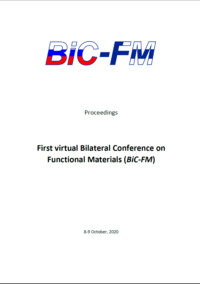Kitap dosya olarak indirilemez ancak uygulamamız üzerinden veya online olarak web sitemizden okunabilir.
Kitabı oku: «First virtual Bilateral Conference on Functional Materials (BiC-FM)», sayfa 12
Investigation of sensory properties of CNT in relation to acetone vapors
Zaporotskova I.V.1, Vilkeeva D.E.1, Elbakyan L.S.1, Dryuchkov E.S.1.
1 – Volgograd State University, Volgograd, Russia
vidinara@mail.ru
Modern methods of diagnostics various diseases, despite their constant improvement, retain the need for fast and inexpensive screening technologies. One of the promising directions in this area is the analysis of exhaled air. Metabolic disorders typical of diabetes mellitus are due to increased acetone content in exhaled air, moreover, selective detection of acetone in breath is very important for diagnosing diseases in a non-invasive way. However, to date, inexpensive portable gas sensors for breath analysis have not been developed. This article provides a theoretical study of the possibility of reacting acetone, a common volatile organic compound (VOC) in human respiration, with carbon nanotubes modified with functional groups – carboxyl and amine. From studies conducted earlier [1,2], it is known, that carbon nanotubes, boundary-modified with carboxyl (COOH) and amine (NH2) groups, form stable chemical complexes. In this paper, we used these sensor models to detect acetone vapor. Calculations of tubulens "zig-zag" (6.0) type were made within the framework of the molecular cluster model using the DFT calculation method. It was found that in both cases a stable chemical interaction is formed. Modified carbon nanotubes can be chemical and biological sensors that make it possible to fix micro amounts of substance. Specified functionalization will ensure high accuracy and selectivity of acetone detection in a complex mixture of gases, vapors and other volatile organic compounds present in exhaled air. Taking into account these features of functioning, it is worth noting the importance of creating a device with a sensor based on modified CNTs for contactless diagnosis of diabetes mellitus.
Acknowledgement.The research was carried out with the financial support of the RFBR and The administration of the Volgograd region in the framework of the scientific project no.19-43-340005 r_a.
References:
[1] I.V. Zaporotskova, N.P. Polikarpova, A.V. Shkodin, D.I. Polikarpov, D.E. Vil’keeva, About boundary modification of nanotube systems by carboxile group, Nanoscience & nanotechnology, 2013, pp. 52–53.
[2] N.P. Boroznina, I.V. Zaporotskova, S.V. Boroznin, E.S. Dryuchkov, Chemosensors, 7 (2019) 1–7.
New ultrathin medical coating of pvp-based medical biliary stents with addition of carbon nanotubes
Zvonareva D.A.1, An E.E. 1, Zaporotskova I.V.1
1 – Volgograd State University, Volgograd, Russia
zvonareva@volsu.ru
We propose as a drug coating a coating based on a known polymer of polyvinylpyrrolidone (PVP) with an injected drug doxorubicin and carbon nanotubes (CNTs), known for their unique sorption and mechanical properties [1–3].
As a result of the experiment, it was found that the most stable is a 60 % PVP solution. After the solution was infused, we divided it into three equal volumes, to which CNTs were added in quantities necessary to create concentrations of 0.1; 0.05; 0.01 wt% CNT. After application and complete drying, the thickness of the created coating averaged 0.02 mm. Then the drug-coated biliary stents were immersed in a saline solution – sodium chloride, which mimicked the internal environment of the human body. [4]
As a result of the study, it was found that the carbon nanotubes present in the coating have a positive effect on the durability and retention of the drug coating on the surface of the biliary stent. The optimal concentration is the concentration of 0.1 wt% nanotubes based on the solution weight.
Acknowledgement.The reported research was funded by Russian Foundation for Basic Research and the government of Volgograd region, grant № 19-43-340005 r_a.
References:
[1] M.T. Byrne, Adv. Mater., 22, pp. 1672–1688 (2010)
[2] L. A. Chernozatonsky, P.B.Sorokin, Carbon nanotubes: from fundamental research to nanotechnology, pp. 154–174 (2007)
[3] Buehler V. Kollidon, Polyvinylpyrrolidone for Pharmaceutical Industry, pp. 287 (1996)
[4] A.G. Beburishvili, I.V. Zaporotskova, E. G. Spiridonov, V.V. Mandrikov, R.A. Shinkarev, Bulletin of VolGMU, 2, 50, pp. 124–130 (2014)
